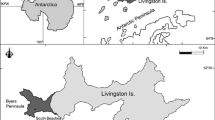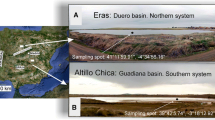Abstract
Intertidal stromatolites, covered by cyanobacterial mats, were recently discovered at Stocking Island, Exuma Cays, Bahamas. Ecophysiological responses (CO2 fixation, N2 fixation, and photoacclimation) of these cyanobacterial mats to experimental manipulations were examined to identify potential environmental variables controlling community structure and function. The mats exhibit horizontal zonation that shifts from soft to crusty to hard in a seaward direction. Cluster analysis of chemotaxonomic photopigments (chlorophylls and carotenoids) revealed that visually distinct mat types are composed of distinct phototrophic assemblages. Under reduced irradiance, diatoms within the mats photoacclimated by increasing accessory photopigments (diadinoxanthin, fucoxanthin, and chlorophyll c 1 c 2) and cyanobacteria reduced the photoprotective carotenoid echinenone. In a 4-day nutrient addition bioassay experiment, nitrate, phosphate, dissolved organic carbon, and trace metal enrichments did not enhance CO2 fixation, but phosphate enrichments tripled N2 fixation rates. The addition of DCMU increased N2 fixation rates relative to nonamended light and dark rates, indicating light (photosystem I) enhanced nitrogenase activity. Soft mats appear to represent the early stages of colonization and stabilization of mat communities. Active growth following stabilization results in the formation of partially-lithified crusty mats, which eventually become highly-lithified and form hard mats. Collectively, our results suggest that Stocking Island stromatolitic mats have low growth rates and consequently exhibit slow responses to increased nutrient availability and changes in ambient irradiance. In general, intertidal stromatolitic mats at Stocking Island appear to exhibit low rates of CO2 and N2 fixation relative to nonlithifying temperate cyanobacteral mats. Although production is low, respiration is likewise low, leading to the suggestion that high production to respiration ratios (P:R) may be necessary for lithification of intertidal stromatolitic mats.
Similar content being viewed by others
References
Bebout B, Paerl H, Crocker K, Prufert L (1978) Diel interactions of oxygenic photosynthesis and N2 fixation (acetylene reduction) in a marine microbial mat community. Appl Environ Microbiol 53:2353–2362
Bebout B, Fitzpatrick M, Paerl H (1993) Identification of the sources of energy for nitrogen fixation and physiological characterization of nitrogen-fixing members of a marine microbial mat community. Appl Environ Microbiol 59:1495–1503
Black M (1933) The algal sediments of Andros Island, Bahamas. Phil Roy Soc Lond 222:165–191
Blumwald E, Tel-Or E (1983) Salt adaptation of the cyanobacterium Synechoccus 6311 growing in continuous culture (turbidostat). Plant Physiol 74:183–185
Canfield D, Des Marais D (1993) Biogeochemical cycles of carbon, sulfur, and free oxygen in a microbial mat. Geochim Cosmochim Acta 57:3971–3984
Chafetz H, Buczynski C (1992) Bacterially induced lithification of microbial mats. Palaios 7:277–293
Drexler A, Morse J, Kornicker W (1988) Controls on carbonate mineral accumulation in Bahamian basins and adjacent Atlantic Ocean sediments. J Sed Petrol 58:120–130
Falkowski P, LaRoche J (1991) Acclimation to spectral irradiance in algae. J Phycol 27:8–14
Fields M (1989) Yachtsman's guide to the Bahamas. Tropic Isle Publishers, Miami
Fischer A (1965) Fossils, early life, and atmospheric history. Proc Natl Acad Sci (US) 53:1205–1215
Gallagher J, Wood A, Alberte R (1984) Ecotypic differentiation in the marine diatom Skeletonema costatum: influence of light intensity on the photosynthetic apparatus. Mar Biol 82:121–134
Klein B (1988) Variations of pigment content in two benthic diatoms during growth in batch cultures. J Exp Mar Biol Ecol 115:237–248
Krumbein W (1979) Photolithotrophic and chemoorganotrophic activity of bacteria and algae as related to beachrock formation and degradation (Gulf of Aqaba, Sinai). Geomicrobiol J 1:139–203
LaPointe B (1987) Phosphorus- and nitrogen-limited photosynthesis and growth of Gracilaria tikvahiae (Rhodophyceae) in the Florida Keys: An experimental field study. Mar Biol 93:561–568
Mann C, Nelson W (1989) Microbialitic structures in Story's Lake, San Salvador Island, Bahama Islands. Palaios 4:287–293
Merz M (1992) The biology of carbonate precipitation by cyanobacteria. Facies 26:105–124
Monty C (1976) The origin and development of cryptalgal fabrics. In: Walter M (ed) Stromatolites. Elsevier, New York, pp 193–249
Moore L (1987) Water chemistry of the coastal saline lakes of the Clifton-Preston Lakeland System, Southwestern Australia, and its influence on stromatolite formation. Aust J Mar Freshwater Res 38:647–660
Neumann A, Gebelein C, Scoffin T (1970) The composition, structure, and erodability of subtidal mats, Abaco, Bahamas. J Sed Petrol 40:274–297
Paerl H (1984) Cyanobacterial carotenoids: their roles in maintaining optimal photosynthetic production among aquatic bloom forming genera. Oecologia 61:143–149
Pearl H (1990) Physiological ecology and regulation of N2 fixation in natural waters. Adv Microb Ecol 11:305–344
Paerl H (1993) Interaction of nitrogen and carbon cycles in the marine environment. In: Ford T (ed) Aquatic microbiology: an ecological approach. Blackwell Scientific Publ., Oxford, pp 343–381
Paerl H, Bebout B, Prufert L (1989) Naturally occurring patterns of oxygenic photosynthesis and N2 fixation in a marine microbial mat: physiological and ecological ramifications. In: Cohen Y, Rosenberg E (eds) Microbial mats: physiological ecology of benthic microbial communities. Am Soc Microbiology, Washington DC, pp 362–341
Paerl H, Joye S, Fitzpatrick M (1993) Evaluation of nutrient limitation of CO2 and N2 fixation in marine microbial mats. Mar Ecol Prog Ser 101:297–306
Paerl H, Bebout B, Joye S, Des Marais D (1993) Microscale characterization of dissolved organic matter production and uptake in marine microbial mat communities. Limnol Oceanogr 38:1150–1161
Perry M, Talbot M, Alberte R (1981) Photoadaptation in marine phytoplankton: response of the photosynthetic unit. Mar Biol 62:91–101
Pinckney J, Bebout B, Paerl H (1994) Salinity and nutrient controls of N2 and CO2 fixation in a tropical hypersaline lagoon: what regulates microbial mat growth? J Exp Mar Biol Ecol (in review).
Reid R, Browne K (1991) Intertidal stromatolites in a fringing holocene reef complex, Bahamas. Geology 19:15–18
Revsbech N, Jorgensen B, Brix O (1981) Primary production of microalgae in sediments measured by oxygen microprofile, H14CO3 - fixation, and oxygen evolution measurements. Limnol Oceanogr 26:717–730
Richardson K, Beradall J, Raven J (1983) Adaptation of unicellular algae to irradiance: an analysis of strategies. New Phytol 93:157–191
Riding R (1992) Tmporal variation in calcification in marine cyanobacteria. J Geol Soc London 149:979–989
Stal L, Van Gemerden H, Krumbein W (1985) Structure and development of a benthic microbial mat. FEMS Microbiol Ecol 31:111–125
Rowan K (1989) Photosynthetic pigments of algae. Cambridge Univ Press, New York
Stewart W, Fitzgerald G, Burris R (1967) In-situ studies of N2 fixation using the acetylene reduction technique. Proc Natl Acad Sci 58:2071–2078
Villbrandt M, Stal L, Krumbein W (1990) Interactions between nitrogen fixation and oxygenic photosynthesis in a marine microbial mat. FEMS Microbiol Ecol 74:59–72
Walter M (1983) Archean stromatolites: evidence of the earth's earliest benthos. In: Schopf J (ed) Earth's earliest biosphere. Princeton University Press, Princeton, N.J., pp 187–213
Webb K, Dupaul W, Wiebe W, Scotile W, Johannes R (1975) Enewetak (Eniwetok) Atoll: aspects of the nitrogen cycle on a coral reef. Limnol Oceanogr 20:198–210
Whittle G, Kendall C, Dill R, Rouch L (1993) Carbonate cement fabrics displayed: a traverse across the margin of the Bahamas platform near Lee Stocking Island in the Exuma Cays. Mar Geol 110:213–243
Whitton B, Potts M (1982) Marine littoral. In: Carr N, Whitton B (eds) The biology of cyanobacteria. Blackwell Scientific Publications, Oxford, pp 515–542
Wright S, Jeffrey S, Mantoura R, Llewellyn C, Bjørnland T, Repeta D, Welschmeyer N (1991) An improved HPLC method for the analysis of chlorophylls and carotenoids from marine phytoplankton. Mar Ecol Prog Ser 77:183–196
Author information
Authors and Affiliations
Rights and permissions
About this article
Cite this article
Pinckney, J., Paerl, H.W., Reid, R.P. et al. Ecophysiology of stromatolitic microbial mats, Stocking Island, exuma cays, Bahamas. Microb Ecol 29, 19–37 (1995). https://doi.org/10.1007/BF00217420
Received:
Revised:
Issue Date:
DOI: https://doi.org/10.1007/BF00217420




